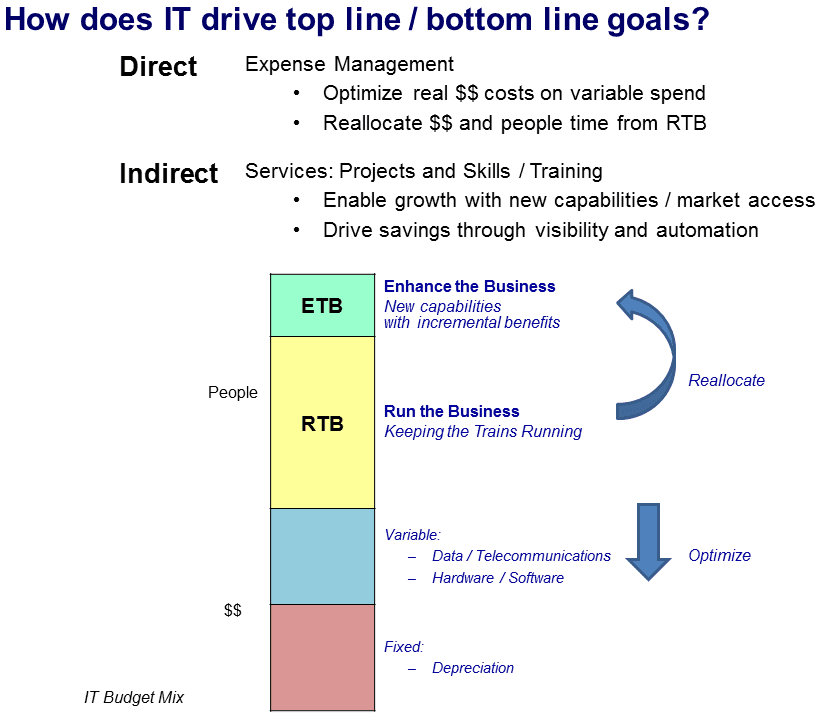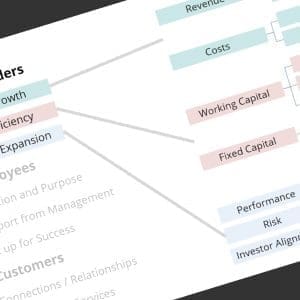The new year approaches, and most IT groups aspire to start out with a completed IT Budget, derived from a well thought out set of short-term Objectives, that align with an IT Strategy – that itself aligns with the overall Corporate Strategy. If your timing is a bit off, and you haven’t established these connections with the process yet – where do we begin?
In my last post, I talked about Timing: get in the conversation early, take an active part in the discovery and formulation parts of strategies & initiatives – and build / modify your IT Strategy accordingly. Sounds great, of course – but if this cadence hasn’t been established yet, where to begin?
A Foundational IT Strategy
The wrong approach would be to fail over to the all-too-common understanding of IT – a cost center, overhead, with limited differentiating value-add. Listen to your IT peers when we get together to commiserate – the talk is focused on complexity reduction and standard work / technology standards, all justified by the need to cut costs. This is important, for sure, but unfortunately, this is where the conversation typically stops. We are reinforcing the perception that IT’s value-add is limited to leveraged cost (doing more with less).
Many organizations are a step beyond that – Sales, Marketing, and Operations see the opportunities, but are frustrated with their IT group’s lack of “agility” when it comes to new technology. It’s a bit of a self-fulfilling prophecy – complexity reduction and a focus on standards, almost by definition, preclude the introduction of anything new.
The trick is to adjust the foundational strategic intent of this bottom line focus in IT – and reintroduce the top-line to our understanding of why we do what we do. And we will do so by embracing our current focus on cost!
Components of the IT Budget
Yup – we start at the end – with a realization that IT is primarily a cost to be managed. However, we need to introduce a wee bit of detail into that oversimplification; think of the IT budget as a mix of different types of cost:
- Fixed / Committed cost – based on actions of the past, there is a certain portion of your IT budget that is committed; depreciation expense is the obvious one, but operational “run the business” resources, dedicated to “keeping the trains running”, will always be part of of the cost structure (unless you want to introduce higher levels of risk – but that is a post for another day).
- Variable / Opportunity cost – Other parts of your IT budget can increase / decrease based on the need for process improvement and innovation; custom programming or implementation of new systems to increase productivity or market & sell to new channels (“enhance the business”, using enabling technology). Another type of “variable” cost – the need for a higher level of quality of service; think about consumables like bandwidth. Want video conferencing or electronic collaboration? Add incremental bandwidth – a discretionary action that can be dialed back when cost pressures emerge.
Another way to understand the difference is time vs. cash; in my IT group, we see time as a finite resource, and folks talk about the split between RTB (Run the Business) versus ETB (Enhance the Business). This distinction is going to be important as we take the next step …

Alignment to Corporate Strategy
Most companies list their overarching objectives to be some variation on the common themes of Make More and Spend Less. Arithmetic kicks in, with the result that an appropriate combination of Making More and Spending Less will deliver on the fundamental goal of all business – to generate profitable growth for the shareholders.
The typical IT organization will have direct impact on the Spend Less side of the equation; we can standardize and optimize our work processes, and leverage our vendor relationships, to drive cost out of IT. The tricky bit is to acknowledge that most Information technology has a fairly indirect impact on the Make More side of things. Yes, technology might open channels and streamline customer transactions, but technology is just part of the solution; critical operational functions like Product Management and Sales & Marketing are the ones that have to communicate, roll out, support, and deliver on an overall initiative to commercialize a new product or service.
A Basic IT Strategic Plan
Applying this to our simplistic IT cost model, we list the first of two basic strategic objectives for IT; focus on the Spend Less side of the equation, driving out cost and optimizing our time by reducing the complexity in the environment, establishing standard work / process, adding automation to eliminate non-value adding work, and aggregating & leveraging our spend.
But here’s the key – we can’t stop there. We need to help drive the top line by working with other functional areas, delivering projects that increase sales and/or margin for the rest of the company. We must optimize and reduce the resources (time and cash) required to Run The Business, and redirect those resources to help Enhance The Business.
Sounds simplistic – but I’m trying to draw a direct line to the Corporate Strategy, which is extremely important. If you talk about the need to implement New Technology X or Version Upgrade Y, you will sound like the stereotypical techno-geek that “doesn’t understand Business”.
But Where is the Innovation?
Ah yes, the refrain of the impatient and ambitious that [correctly] want IT to contribute, even lead, the charge to Innovation – with all of that exciting and interesting technology that vendors continue to market to everyone (except IT). I don’t mean to sound too cynical there, because this is precisely the question that IT needs to ask itself. We must deliver value by bringing new ideas and enabling technologies to the table, and we must be flexible enough to adapt and incorporate new ideas / technology when they do not originate from IT.
In this first-cut of an IT Strategy, there is no innovation component – yet. You have to walk before you run, because Execution Excellence – getting the basics right – is table stakes, your ticket in the door. By establishing this foundational IT Strategy, delivering predictable, reliable, transparent results – and then working our way into the strategic and operational planning cycle – we can get to the position of thought leadership and innovation that fits correctly into the particular cadence of the company.





Comments (0)